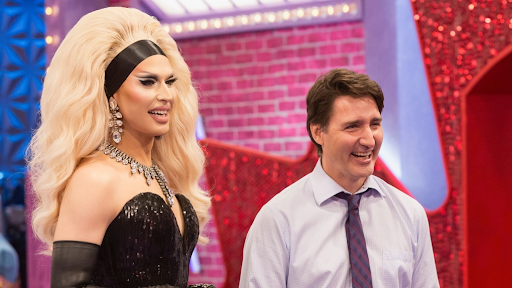Wrapped in silk and satin, dripping in jewels, and serving everything from camp to opulence, the queens of “RuPaul’s Drag Race” have dazzled the world with their charisma, uniqueness, nerve, and talent since the show’s inception in 2009.
From being called a small parody show of America’s Next Top Model, “RuPaul’s Drag Race” has grown into a cultural phenomenon, spawning several spin-off series, and numerous international franchises over a decade. American drag icon Charles RuPaul, one of the most iconic superstars of this century, brought the art of drag to mainstream television, and in turn, gave the community a public platform.
Seeing drag queens on the big and small screen used to be unheard of, especially in the early 2000s. “This show started made by queer people for queer people on a very small, queer cable network,” Michelle Visage, one of the mainstay judges of “RuPaul’s Drag Race” said in an interview with Variety. Now, the show has earned six consecutive Emmy wins for RuPaul, and four Emmys for the show itself.
“RuPaul’s Drag Race” has quite literally, changed television. The show continues to explore how drag culture is deeply rooted in mainstream pop culture, giving the drag community the voice and credit they’ve always deserved through much-needed mainstream representation in a completely authentic and unfiltered format—-a reality show.
Cultural force
“RuPaul’s Drag Race,” first aired on the LGBTQ-centered network Logo TV, introduces a set of different drag queens who want to become “America’s next drag superstar.”
In the race toward the crown, the queens go through various challenges. They compete in design challenges where they have to create and produce extravagant runway outfits, music and dancing challenges that involve writing lyrics for their own songs; and even acting challenges where they star in their own commercials for make-believe products. One of the show’s most anticipated challenges is “Snatch Game” where queens have to impersonate a famous celebrity and make the audience laugh with impromptu jokes as they interact with their fellow contestants.
The queens who don’t do well in these challenges are given a chance to stay in the competition through a “lipsync for your life” battle, which has produced countless memes and internet cultural moments. The queens go all-out with several tricks up their sleeves, such as confetti-laced wigs or even hidden butterflies in their palms.
This competition format, which has undergone many changes through the years, is meant to showcase the various talents, stories, and cultural creations the drag world has to offer, making it accessible to an entirely new audience.
The once low-budget niche show has drawn a wider, more diverse audience over the years, making the art of drag a viable career path for members of the queer community. Live performers, such as drag queens, did not have many opportunities to get paid for their craft. But “RuPaul’s Drag Race” has since inspired a global community of fans, while also producing an array of aspiring queens all over the world.
The series has launched the careers of numerous drag superstars, who have, in turn, introduced diversity within the drag world to the general public. The likes of Trixie Mattel, Monèt X Change and Bianca del Rio are now household names, earning millions of dollars and clinching gigs hosting for major streaming sites such as Netflix, or even releasing full-length movies in cinemas.
Game-changer
“Drag Race” has been credited as a game-changer, giving the often marginalized LGBTQ community a platform in a world that has continuously discriminated against them.
In its earliest seasons, during a time when LGBTQ representation in mainstream media was few and far in between, “RuPaul’s Drag Race” became a platform for the real and often sidelined struggles of the queer community. It became a safe space for community members to share their stories, such as the constant discrimination and marginalization they’ve had to endure, and stories of family and friendship unique to the LGBTQ experience.

‘DRAG HANBOK’ Korean American drag queen Kim Chi showcases Korean culture through her iteration of the traditional Korean attire, the hanbok. Source: World of Wonder.
In its first season, competitor Ongina opened up about the struggles of living with HIV, a disease that heavily impacts the LGBTQ community, and subjects them to discrimination and stereotypes. Yet, Ongina openly admits how she’s been living with the disease, entering the show with optimism and showing the world how she found the courage to continue living: “Life is a celebration.”
Before gay marriage was even legalized in the United States, then Season 4 (2012) drag contestant Chad Michaels spoke about the lack of healthcare access for same-sex partners to make medical decisions for their significant others, especially during emergencies, because of the lack of marriage equality.
Issues of acceptance within different filial cultures were also brought to American households, through Korean American drag queen Kim Chi’s runway “drag hanbok” in Season 8, where she shared her story of how her conservative family was still unaware of her sexual orientation as a gay man and gender expression as a drag queen.
“Throughout the history of the gay-rights movement, drag queens have always been at the forefront,” show creator RuPaul says in an interview with The Washington Post. “We threw the first brick at Stonewall and this show gives us the chance to not only tell our history, but to inform young people about the rich cultural heritage that their brothers and sisters before them have created.”
International impact
As of writing, the show has international editions in the United Kingdom, Australia and New Zealand, which are hosted by RuPaul. Other franchises such as in Chile, Thailand, Canada, the Netherlands, Spain, Italy, France and the Philippines also became successful. The international editions of Drag Race are instrumental in bringing together a global community of drag queens, showcasing the differences and similarities of local queer communities.
Like Kim Chi, Drag Race became instrumental in bringing together immigrant families, this time in the United Kingdom. Drag Race UK contestant Sum Ting Wong, who hails from a Chinese-Vietnamese immigrant family, said in a recent BBC interview that the show motivated her to come out to her family. “If I didn’t go on the show, I honestly feel like I might have kept this from them for the rest of my life,” she said to the BBC.
Sum Ting Wong also shared stories of how she received messages from other young LGBTQ+ people who were inspired by her appearance on the show. “I’ve been contacted by young Muslim and young Pakistani kids saying the show has helped them, especially in terms of coming out,” she said to BBC.
Drag Race goes Glocal
The mainstream representation of the queer community in the form of RuPaul’s Drag Race has greatly helped change live culture for drag queens all over the globe. Being part of one franchise, global fans are able to view the cultural nuances of different local drag scenes, with unique depictions of drag as a celebrated art form.
The international franchises also help shine a light on each local drag community, as they “glocalize” the show. Instead of the usual American format, the challenges are modified to match each country’s history and culture.

‘DRAGNA’ The queens of Drag Race Philippines pose as the drag version of the iconic Philippine comic book hero “Darna.” Source: World of Wonder.
In the Philippine edition, queens are made to play traditional games and dress up as local superheroes for their mini challenges.
In traditional and religious countries like the Philippines, the show has given drag queens a viable means of livelihood, while also showing their stories to a conservative audience.
Queer representation is a rarity in many countries, despite the many signs of progress the Pride movement has achieved. Same-sex marriage is still banned in the Philippines, and an anti-discrimination bill was recently rejected by local congress. The country also rejected the United Nations’ endorsement to legalize same sex marriage in a recent conference.
In Drag Race España, one of the most acclaimed international editions of the franchise, the talent show challenge serves as an avenue for queens to show the many faces and traditions of Spain. Contestant Drag Sethlas even brought the Canary Island carnival to the show, wowing with her impressive salsa dance moves and Olympic-level tricks, and representing her hometown on the main stage.
Meanwhile, in Thailand, instead of solely focusing on the winners of the weekly challenges, drag queens are expected to present their stories through their extravagant runway looks, placing emphasis on beauty, fashion, and pageantry.
The local iteration of Drag Race is also hosted by Thailand’s very own legend, Pangina Heals, who explains the cultural nuances of the local drag scene. The queens are often clad in Thailand Regalia, bringing their tradition to each runway.
Heals has also shared how the show was also instrumental in introducing a different side of drag queens to Southeast Asia, and credits the show for the growing popularity of drag culture in Thailand.
Heals emphasized how Drag Race has changed the perception of drag queens in Thailand, bringing the drag scene from “night clubs” to mainstream television and live shows.
“Firstly, people view drag more as art now, rather than as, ‘Oh my God, they’re creatures of the night and they prey on men like black widows!’ Now they can say, ‘They’re just artists. It’s just someone who appreciates the art of transformation and the art of performance and the art of makeup, and someone who wants to entertain other people,” she said in an interview with The Queer Review.
Drag Race Thailand also reflects Thai society’s general tolerance and acceptance of the LGBTQ community, with its Season 2 Winner Angele Anang being the first trans queen to win a season. The show has also started groundbreaking conversation on marriage equality in the country, with Thailand on the precipice of legalizing same sex marriage.
Drag Race vs the World
Drag superstar Pangina Heals, also represented Thailand on “Drag Race vs the World” UK Edition.
In a divided world, so many languages and cultures come together in “Drag Race vs The World.” Its first edition, with the United Kingdom as the “host nation,” brought together girls from all over the world to compete for the title of “Queen of the Mothertucking World.”
This edition of drag race is a vehicle for a global exchange of cultural experiences, with each queen from a different country bringing their own drag to an international stage.

Source: World of Wonder.
Canadian Prime Minister Justin Trudeau even appeared on Canada’s edition of Drag Race vs The World, bringing a message of allyship to the LGBTQ community. Trudeau is the first world leader to appear on the show, which embodies how its cultural impact has reached even those in seats of power, with politics coming into play.
With Trudeau’s visit, Canadian immigrant and drag race contestant Stephanie Prince was moved to tears, as she brought up how the country’s immigration policies have affected performers like her: “People like him, made it easy for immigrants to migrate here and have a chance for a better life. Seeing him being here is so nice, so I thank him.”
“Drag is all over the world, it’s a phenomenon, it will live on and on,” RuPaul sings in their 2021 hit single “Phenomenon.” It’s a prophecy fulfilled, as the show has now crossed borders and broken barriers, bringing together drag queens all the way “from Russia to the UK, Thailand to Paraguay, Vegas, New York and LA” and proving once and for all that “Drag Race” is here to “shantay” and stay.
- In Medias Res: How the press makes and breaks global affairs - October 31, 2023
- Fact checkers on the digital front lines: The war against disinformation on social media - August 3, 2023
- Trash talking: The imperialism of the global waste trade - May 14, 2023






